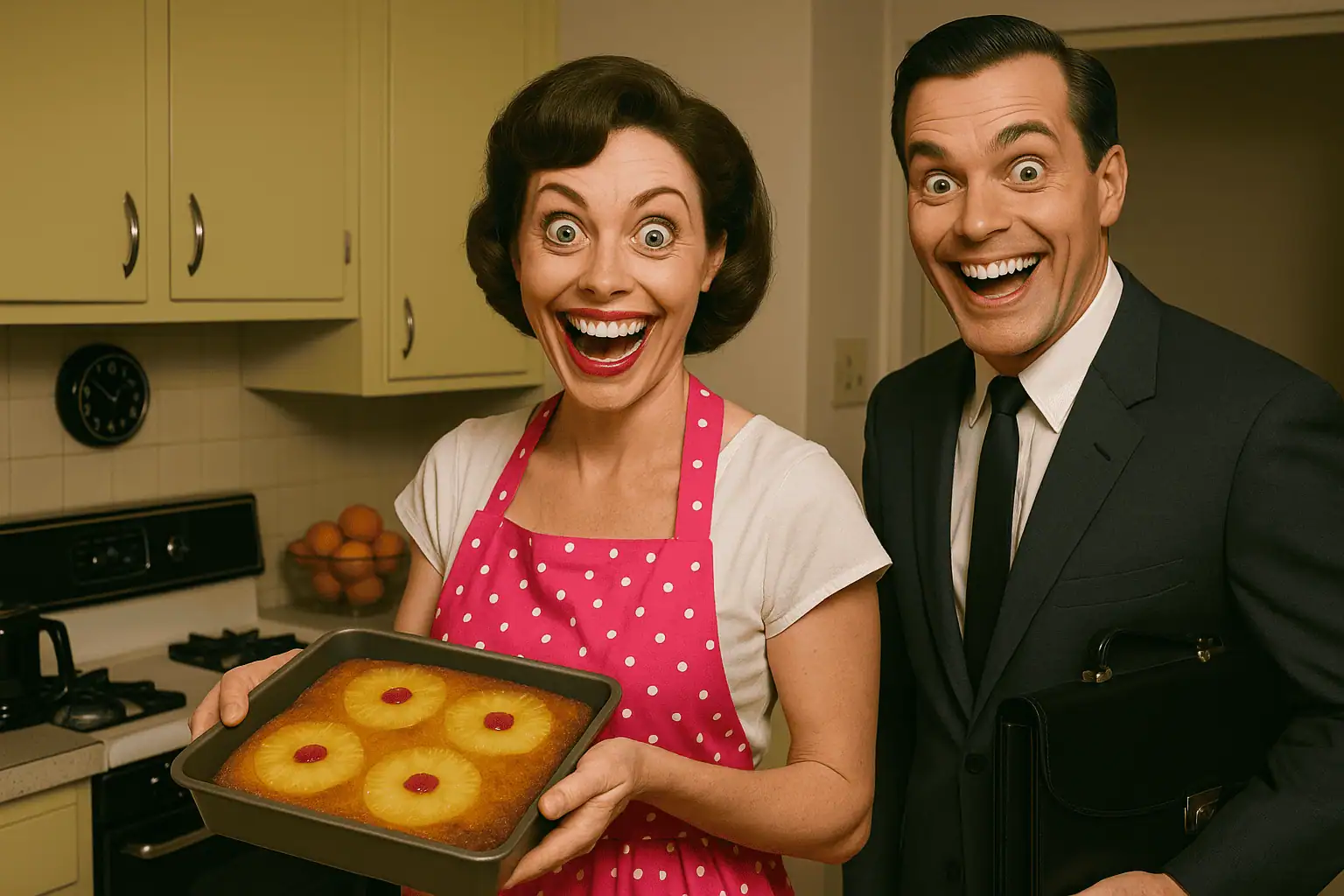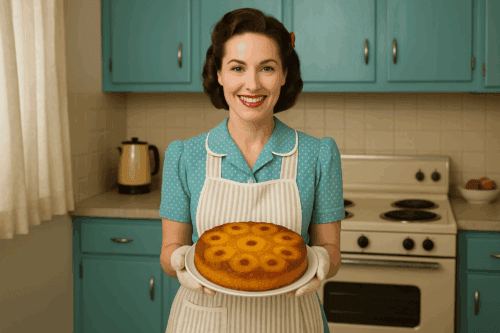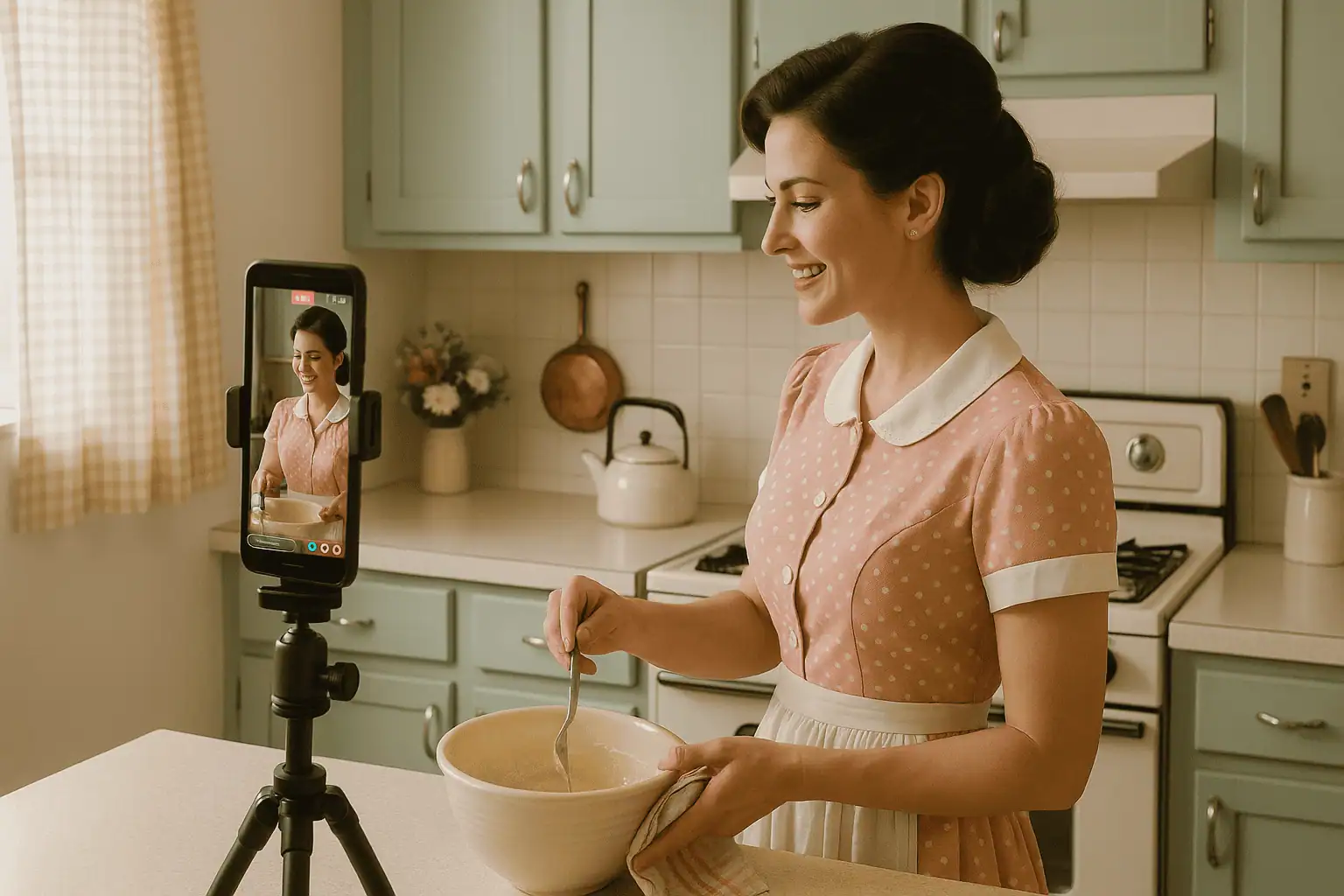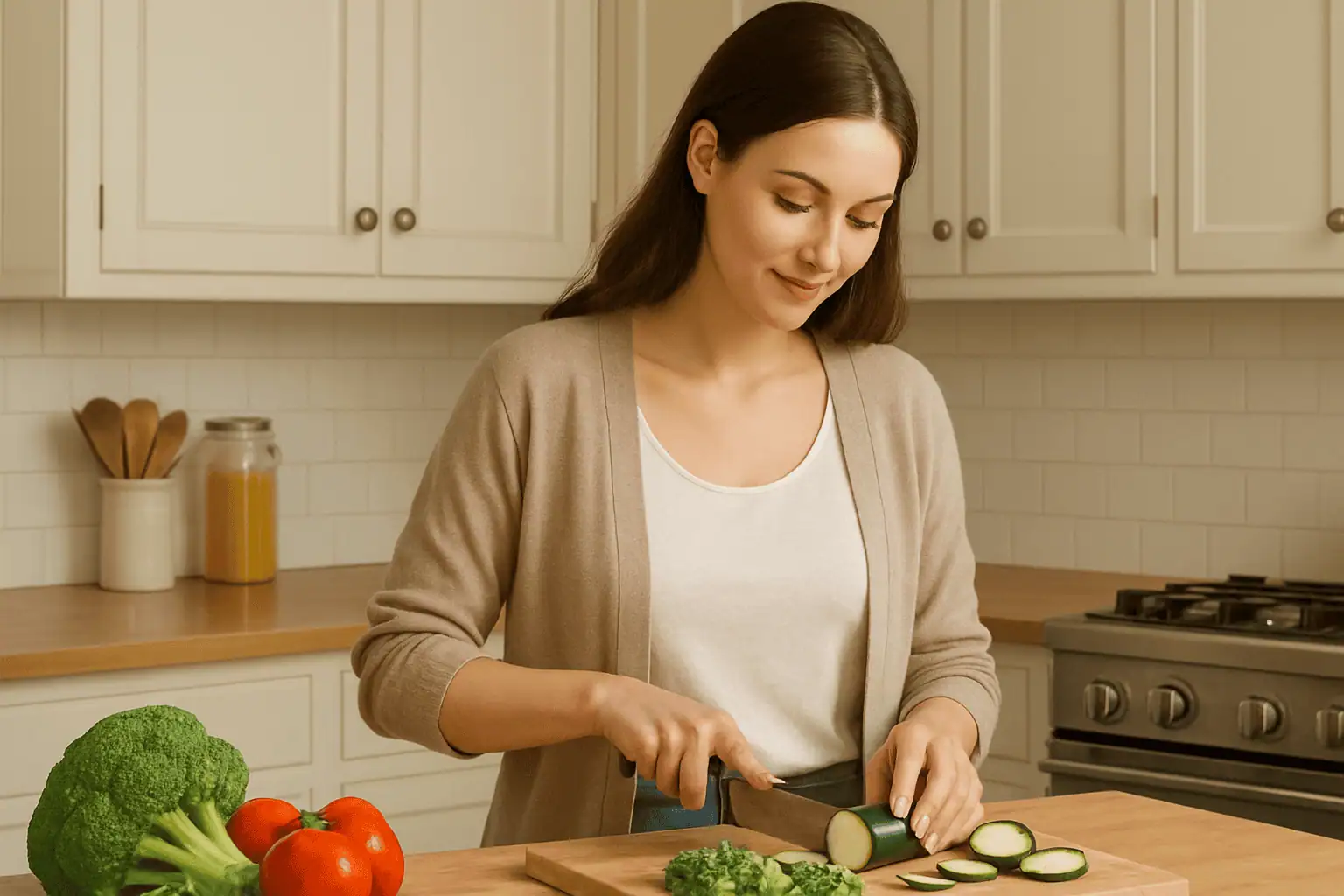
The Trad Wife Life
Why the 1950s Housewife Trend Is Stirring Up Controversy
A perfectly made-up wife in a retro apron pulls a casserole out of the oven just as her husband walks in from work. She’s smiling (of course), the house is spotless, the children are well-behaved, and dinner is right on time. On social media, thousands of young women are aspiring to make this 1950s fantasy their reality. They call themselves “trad wife” influencers, short for traditional wife, and their videos are blowing up. In an age of #GirlBosses, a corner of the internet is praising traditional gender roles and declaring that a woman’s place is, well, back in the home. It’s a cultural phenomenon that has both fans and critics in a tizzy. Is it a harmless lifestyle choice or a step backward for women’s rights? Let’s dive into the curious world of the tradwife movement with a journalistic eye – and maybe a pinch of sarcasm.
What Exactly Is a Trad Wife Trend?
The term tradwife stands for traditional wife and centers on old-school marriage roles. A tradwife embraces being a homemaker, a loyal spouse, and a domestic queen in the kitchen. The tradwife trend has exploded on social media over the last few years. Influencers showcase vintage-style lives where homemaking looks effortless and dreamy. They post videos of themselves cooking, cleaning, and raising kids while smiling sweetly. Platforms like TikTok and Instagram are flooded with their soft-filtered homemaking scenes.
The whole vibe is a clear throwback to 1950s traditional values about home and family.
A Vintage Fantasy, Rebooted Online
But unlike your grandma’s day, today’s tradwives are Gen Z and millennial stay-at-home mom aspirants who are very online. They share “day in the life” vlogs of ironing linens and roasting chickens, usually set to quaint music. One moment you’re scrolling your feed, and suddenly you stumble on a 25-year-old in a floral dress explaining how fulfilling it is to stay home and serve her man fresh pie every week. Within minutes, the algorithm might show you dozens more, all preaching the gospel of traditional gender roles in modern times. (Yes, the internet’s world of infinite niches now includes a 1950s housewife cosplay community. Surprise!)
According to The New Yorker, interest in the tradwife phenomenon hit a fever pitch last summer when a crop of these influencers soared in popularity. They present kempt, feminine images of domestic bliss – garnering millions of followers – by embracing what many would call hyper-traditional roles in marriage and homemaking. Their ranks include women like 22-year-old Nara Smith, who literally makes her own cereal and toothpaste from scratch, and Hannah Neeleman, a Utah mother of eight children who posts idyllic farm scenes of her brood. In short, the trad wife life is portrayed as wholesome, simple, and oh-so-satisfying for the woman who chooses it.
A 1950s housewife proudly displays a homemade pineapple upside-down cake. Many trad wife influencers recreate this kind of vintage domestic scene in their content – perfect makeup, home-cooked meals, and a big smile to boot.
The Allure of the 1950s Aesthetic
Why are many women (some startlingly young) suddenly enchanted by June Cleaver’s world? Part of it is the aesthetic. The tradwife lifestyle online is often presented with a heavy dose of nostalgia: flowy dresses, aprons, fresh-baked bread, and sun-dappled kitchens. It’s like Instagram filtered through a Little House on the Prairie lens. The daily grind of modern life – the commute, the emails, the hustle – is traded for an idealized family life full of home-cooked meals and hand-sewn clothes. For viewers burned out by 24/7 hustle culture, watching someone lovingly canning peaches or knitting baby booties can weirdly feel like escapism. (Cottagecore, but make it patriarchal.)
There’s also a romantic appeal to the clear division of gender roles. Proponents say it looks comforting: the husband as provider, the wife as homemaker. No messy negotiation of who does the dishes – it’s all predetermined. One young man I saw commenting on a tradwife video wrote, “Where do I find one?!” presumably because a cheerful partner handling the home while he earns the paycheck sounded pretty good to him. And indeed, some young women see contentment in the tradwife model: they often talk about finding joy in “simpler times” and in taking care of their own children and house without the stress of a 9-to-5 job.
In these videos, the traditional wife ideal is painted as a form of luxury. You’ll see a woman in a spotless kitchen icing a three-layer cake while toddlers play quietly at her feet. She’s dressed as if she stepped out of a mid-century ad (pearls, curls, and all). The fantasy says: you too can have a serene life of baking, gardening, and child-rearing – if you fully embrace being a stay home wife and mom. It’s domestic bliss, presented almost like a spa retreat from the modern working world.
Estee Williams: The Face of the Trend
This movement has its fair share of social media stars. One of the most well-known is Estee Williams, age 26.
She’s an American influencer who channels serious Marilyn Monroe vibes. Picture Marilyn, but make her a cheerful homemaker on TikTok.
Estee blew up in 2022 with videos on vintage hair and “Christian wife” tips. She’s made the rounds on talk shows like Dr. Phil and Piers Morgan. They’ve dubbed her a leading face of the trad wife trend. In one viral video, wearing an apron, she smiles and says, “Don’t tell the feminists but I love to stay at home and cook and clean.” (Cue the provocative wink.)
How to Be a Trad Wife, According to Estee
Estee often lays out tips for being the ideal traditional housewife. If I had to summarize her advice from various videos into a short list, it would go something like:
- Look feminine and put-together: Embrace dresses, do your hair and makeup – essentially, “keep yourself attractive” for your husband.
- Master cooking and baking: The way to a man’s heart is through his stomach, right? She’s constantly cooking hearty meals from scratch. Sourdough bread, anyone?
- Cultivate a peaceful, positive attitude: No nagging here. She preaches being friendly, cheerful, and at peace with your life (and with male leadership in the home). One video literally advises wives to “smile more.”
- Be fit and healthy: Hit the gym, take care of your body. A trad wife is often shown doing yoga or going for runs to stay slim and energetic for her family.
- Practice faith and prayer: Many tradwives, Estee included, anchor their lifestyle in religious traditional values. Praying for a good husband and being a “Godly wife” is part of the package.
- Submit to your husband’s lead: This is a big one – they repeatedly emphasize respecting the man’s authority. “Wives should submit” is basically a trad wife tagline (more on that in a moment).
That last point is where a lot of people (myself included) raise eyebrows. It’s not just home decor tips and recipes these influencers are sharing; it’s a return to a power dynamic where the male is firmly the head of the household. Many women find that idea at best old-fashioned and at worst dangerously regressive.
Hannah Neeleman: The Farmhouse Fantasy
Other notable tradwife influencers include the aforementioned Hannah Neeleman, known for her handle @ballerinafarmon on Instagram. Hannah is a former Miss Utah who lives on a rural farm and recently won a “Mrs. America” pageant – all while raising eight children. (Yes, you read that right, eight.) On her feed you’ll see rosy-cheeked kids, farm animals, and Hannah in denim overalls cooking farm-to-table feasts. It’s the trad wife life turned up to 11: she’s literally got the big family, the bread-baking, and the beauty queen crown. Oh, and a fun fact: her family has some serious wealth – her husband’s father founded JetBlue Airlines. So behind that bucolic fantasy of a simple farm life, there’s a lot of privilege making it possible. (I don’t know about you, but maybe it’s just me, I suspect having a millionaire family safety net makes being a one-income household a tad easier!)
Nara Smith: Handmade Everything
And let’s not forget Nara Smith, who at only 22 has become a tradwife icon on TikTok. She’s married to model Lucky Blue Smith, and together they have a beautiful young family with multiple kids already. Nara’s shtick is making everything by hand – we’re talking grinding her own peanut butter, baking bread daily, even DIY toothpaste. Her content shows an idea of domestic perfection so extreme it almost looks like satire: picture a glowing mom of three under age 3, effortlessly kneading dough and teaching the toddler ABCs.
The internet can’t decide if she’s for real or doing an elaborate performance art piece about how absurd expectations on mothers can be. Nara insists it’s genuine, and millions tune in to watch her “from scratch” lifestyle. She’s even been profiled in GQ and The New Yorker. Love it or hate it, she’s at the heart of the trad wife phenomenon, embodying both the allure and the skepticism around it.
[Would You Ever Want to be a Tead Wife Poll Infographic]
We asked our Female Jack and Jill Adult Readers on Instagram if they would like to be a trad wife

“We’re Not Anti-Feminist, But…” (The Philosophy Explained)
The tradwife influencers are quick to claim that what they’re doing is empowering – just in a different way. They often frame it as choosing to be a homemaker, rather than being forced. Estee Williams, for example, explained in one of her TikToks that “We believe our place… our purpose is to be homemakers. It doesn’t mean that we are trying to take away what women fought for.” In other words, she says, “Hey, I’m not against career women or women’s rights. I just personally feel my calling is to be a wife and mother.” It’s pitched as a personal lifestyle choice, a preference, not a political statement.
Then usually comes the just me defense: “It’s just what works for me, personally!” They very much emphasize that nobody is forcing them into this role – on the contrary, they decided to leave careers or forego outside work because they feel happiest and most natural running a home.
But (and it’s a big “but”) – the critics aren’t convinced it’s that innocent. Because in the next breath, trad wives often tout some pretty blatantly anti-feminist ideas. In that same video, Estee went on to say, “Tradwives also believe that they should submit to their husbands and serve their husbands and family.” Ah, there it is. The S-word – submit. They openly promote a wifely submission doctrine that sounds straight out of a 1950s marriage handbook.
What’s rarely mentioned, though, is that submission doesn’t have to flow only one way—plenty of modern couples are flipping the script, exploring dynamics where the husband submits in private, often with the help of male sub toys that make the power play even more tangible. In another viral clip, an apron-clad influencer giggles, “Don’t tell the feminists but I’d rather stay home and obey my husband than work a job.” It’s played as a cheeky joke, but the underlying message is clear: they take a dim view of the whole women’s liberation thing.
This is where many observers go, “Wait, haven’t we seen this movie before?” A historian interviewed by Vogue noted that the language of wifely submission echoes legal frameworks of the 18th century, when married women lost their independent legal identity and any money they earned became their husbands. Back then, a married woman couldn’t have her own bank account (banks didn’t let women get credit in their own names even until the 1970s in some places). She generally had zero political power and limited rights. So hearing young influencers today chirping about how women should be subservient “like the good old days” is alarming to those who remember that “good old days” weren’t actually so good for the woman in that equation.
Zara Hanawalt put it bluntly: “The most troubling component is women not just accepting this but advertising it as a viable or preferable way of life.” In other words, it’s not just that a few women are privately choosing to be homemakers – they’re publicly selling the idea that all women would be happier if they relinquish equality. That raises the stakes from “harmless personal choice” to something potentially influencing society and young girls’ expectations.
A Backlash to Modern Feminism (or Just Burnout?)
So what’s driving this weird counter-feminist trend? On one level, the tradwife craze is a backlash to what some see as the failures or pressures of modern womanhood. Second-wave feminism (the movement in the 1960s-70s that fought for equality in workplaces, education, etc.) told women, “You can be anything!” But in practice, a lot of women today feel like that became “you must be everything.” Have a career, raise perfect kids, keep a Pinterest-worthy home, maintain a social life, and look fit and gorgeous through it all – an exhausting juggling act. The feminine mystique that Betty Friedan identified (the problem of suburban housewives feeling unfulfilled) has almost flipped: now the corporate lifestylecan leave women frazzled and missing family time.
Enter the tradwife, who says: Put down the briefcase, pick up an apron, and your life will be simpler and more fulfilling. It’s almost a seductive pitch. Society hasn’t solved the work-life balance conundrum – child care is wildly expensive, workplaces often lack flexibility, and women still do the lion’s share of housework even when working (the old second shift).
The Appeal of Opting Out
Trad wives tap into that frustration. They offer an idea: what if, instead of “leaning in” harder at work, women just opted out and leaned into home? No daycare drama, no glass ceilings, no trying to be “Superwoman” doing it all. Just focus on your marriage, your babies, your cozy kitchen. Some proponents frame it almost like a strike: “modern workplaces don’t accommodate moms, so I choose to value raising my kids and keeping a home instead of killing myself for a corporation.” When phrased that way, it doesn’t sound so crazy, does it? It even has a whiff of counterculture rebellion – rejecting capitalist burnout culture for a simpler domestic life.
When Nostalgia Turns Political
There’s also a political and cultural backlash element. In recent years, we’ve seen a rise of conservative and even far-right rhetoric idealizing “traditional families.” Every time there’s progress in women’s autonomy or LGBTQ+ visibility, there’s a counter-current longing for the “good old days” of clear-cut roles. Some tradwives explicitly position themselves as anti-feminist because they believe feminism “went too far” by encouraging women to prioritize careers over family. They’ll say things like, the only reason many women are unhappy is because they’ve been told not to be good wives and mothers. In their view, the feminist movement tricked women into abandoning traditional roles where they were supposedly much more content. (This conveniently ignores that women fought pretty hard to escape those roles, but hey, revisionist history is a hell of a drug.)
The Whiteness of the Tradwife Fantasy
Let’s address the elephant in the room: some of the tradwife trend has been co-opted by the far right. No, not every tradwife is a crypto-fascist—but the overlap in messaging is real. Extremist groups have long promoted ideas like boosting white birth rates and returning to rigid gender norms. The soft-focus, apron-clad homemaker content can become a gateway to something darker.
One media watchdog found that after a few tradwife TikToks, the algorithm pushed far-right conspiracy content “within an afternoon.” Even Estee Williams, a top tradwife figure, was indirectly linked to accounts sharing racist and homophobic content. According to The New Yorker, her Instagram was only a few clicks from some disturbing corners of the internet.
Beyond extremism, tradwife discourse often paints a 1950s fantasy that simply wasn’t real for everyone. It centers white, middle-class women and erases the reality for many others. In the ‘50s, Black women and other women of color often worked outside the home—usually as maids or laborers—because they had no choice. They didn’t get the luxury of staying home to bake pies and raise babies in air-conditioned kitchens.
Today’s tradwife influencers are mostly white, often Christian, and carefully packaged in aesthetic perfection. As Voguenoted, this “submissive white womanhood” image carries heavy racial and class privilege. It’s easier to play June Cleaver when your family history isn’t rooted in systemic survival. For many women, the fantasy was never theirs to begin with.

Modern “trad wife” influencers often present a collage of the past and present – mixing vintage domestic imagery with smartphone-era branding. In this image, the wife is live-streaming her tidy 1950s-style kitchen, symbolizing how today’s traditional wife trend merges old-fashioned ideals with new tech on social media.
The Privilege (and Irony) of the Trad wife Lifestyle
Being a full-time homemaker in 2025 is a privilege that most women cannot afford. In the 1950s, a family could often live on one income – partly because of post-war economic booms, strong unions, and, yes, government programs (the GI Bill, social security expansions, etc.). Nowadays, good luck buying a house or raising multiple kids on a single middle-class salary. As much as these influencers coo about a “simpler life,” it’s simply not financially feasible for many families to have a stay-at-home parent.
Tradwife influencers conveniently gloss over this. Many of them, truth be told, have safety nets or alternative income streams. A dirty little secret is that some of these women are making bank from their trad wife content. Irony of ironies: they preach wifely dependence on a husband, but behind the scenes they’ve got a hefty influencer bank account. Sponsored posts, YouTube ad revenue, affiliate links for those cute aprons and vacuum cleaners – it adds up. One popular stay-at-home girlfriend turned TikToker, Alexia Delarosa, admitted on TV that she earns “enough to pay all the bills” just from posting content. So while she calls herself a homemaker, she’s functionally the breadwinner via Instagram. Similarly, tradwife influencers like Estee or Hannah often have e-commerce shops or Patreon subscriptions. They aren’t exactly living solely off hubby’s paycheck. They found a 21st-century way to monetize the tradwife lifestyle brand.
The Risks Hidden in the Trad Wife Life
Meanwhile, this trend might give the average woman a rude awakening. If she quits her job and later her husband loses his, or if the marriage turns sour, she could be in a very vulnerable spot. Financial dependence is risky; domestic life isn’t all baking cookies, it can also mean having no fallback if things go wrong. Critics worry that glamorizing this lifestyle might encourage women to give up their autonomy prematurely.
As one skeptic online quipped, “Sure, being a tradwife seems fun until you need to escape a bad situation and realize you have no income, no degree, and no credit history of your own.” In extreme cases, a woman fully dependent on a man might feel unable to leave even if there’s abuse – raising concerns about increased risk of domestic violence, forced creampies, or exploitation. The tradwife crowd tends to wave those concerns off with a manicured hand, insisting that if you pick the right man and live virtuously, everything will be dreamy. (If only life were that simple, right?)

Polished to Perfection: The Face of Today’s Tradwife Fantasy
Not Your Grandma’s Housewife: Feminism Strikes Back
It’s no surprise that feminists – especially women who remember the mid-20th century or whose mothers told them stories – are side-eyeing the tradwife trend hard. One might ask: Why would women voluntarily resurrect a role that feminism spent decades dismantling? Women in the 1960s literally burned bras and marched in the streets so their daughters wouldn’t be limited to the title of “housewife.” They fought for the right to have careers, to control their reproductive lives, to get an education, to have a say in society outside the home.
The second wave feminism era gave us legal protections against employment discrimination, opened up universities to more women, and yes, made it possible for a wife to open her own bank account and get a credit card without a male cosigner. (Imagine calling Chase Bank today and them saying, “Sorry, little lady, better have your husband sign for that Visa.” That was not long ago!)
The Trad Wife Life and the Obedience Trap
Seeing young women today tweet that it’s “women’s natural role” to be homemakers feels like a slap to those who know the history. As one New Yorker writer pointed out, for readers of Betty Friedan or viewers of Mad Men, it’s bizarre to glamorize mid-century housewife life as anything but suffocating.
Friedan’s 1963 book The Feminine Mystique captured the silent desperation behind the perfect kitchens and polite kids. Many housewives were quietly miserable, popping Valium and downing martinis by noon out of boredom and lost identity. That book helped ignite a movement because the “dream” of staying home wasn’t delivering real fulfillment.
Traditional values defenders will argue, “But those families had stability! Today’s women are single and miserable with cats!” Being a stay-at-home mom can absolutely be fulfilling, and no one should shame women who choose that path. Feminism, at its core, is about choice—whether that means being a CEO, a homemaker, or something in between.
Tradwives only raise eyebrows when “personal choice” morphs into a one-size-fits-all blueprint for women. When the conversation shifts toward rewinding society, people get uneasy. It’s fine if one woman wants to stay home. It’s another thing entirely to suggest all women belong there.
The online tradwife movement isn’t just about lifestyle aesthetics. It carries strong political undertones. Some messages echo anti-feminist ideas and downplay hard-won women’s rights. And while tradwife content goes viral, real-world freedoms—like reproductive rights—are quietly being rolled back across several states.

A modern mother is preparing vegetables for her family meal. Today’s tradwives say they find empowerment in dedicating themselves to home and family, a role some women genuinely love. But unlike the 1950s, now it’s a lifestyle choice rather than an absolute expectation – and most families depend on two incomes, making the full-time homemaker route less common.
Is the Trad Wife Life for Real or Just an Online Aesthetic?
After wading through the perfectly frosted facade of tradwife content, you might wonder how much of this is sincere versus clickbait. The cynical take is that a lot of it is performative – a curated fantasy akin to those “cottagecore” or homesteading influencers who show the pretty parts and not the mess. It takes a lot of work to make domestic labor look effortless. One trad wife might spend all day cleaning, homeschooling, and cooking, but her Instagram will only show the final pie on the windowsill and the kids in matching outfits singing a hymn. The stressful or mundane parts (screaming toddlers, financial stress, personal ambitions sacrificed) are off-camera. So the viewers get an edited reality. A 1950s sitcom rerun plays out, not a documentary.
Behind the Apron: Performance or Reality?
Some commentators suspect that a few of these influencers are almost role-playing, adopting a persona for clout. For example, when one tradwife TikToker went viral, internet sleuths found she was once an outspoken career woman. She had embraced a very different life just a couple of years before. Did she genuinely change her views on marriage and gender roles? Or did she spot a niche and rack up followers by acting like a blissful Stepford wife? Only that person knows. But in the age of social media, we know people often exaggerate or caricature themselves to gain an audience. It’s the modern influencer economy: find a niche, commit to the bit, build a following, monetize.
There are certainly women who truly live this way off-camera. Many families operate on one income with a homemaker mom (though usually not with the Victorian cosplay flair). Those women might not call themselves “trad wives,” a word that comes with a lot of online baggage, but functionally, they are traditional homemakers. They’re not trying to start a movement; they’re just living their lives. They have that choice. The difference is that they don’t insist everyone else should do the same, and they’re not hashtagging #tradwife about it.
A Retro Dream with Modern Wrinkles
The trad wife phenomenon is a head-scratcher, alright. On the surface, it’s just individuals romanticizing a retro way of life – part innocent nostalgia, part Instagram theater. It speaks to legitimate frustrations (work-life imbalance, economic pressures, longing for “simpler times”) and packages them in a visually appealing, sweet-as-apple-pie image. For some women, it may indeed be a fulfilling path. There’s nothing wrong with valuing family and domestic work; in fact, one could argue society should value caregivers more.
However, when a personal choice becomes a public crusade or a social media fad, we have to look closer. The tradwife trend raises important issues about gender roles, equality, and how we adapt (or don’t) to the modern world. It’s one thing if Jane wants to be a homemaker; it’s another if a bunch of influencers subtly (or not so subtly) suggest that all women are better off in the kitchen and nursery.
The Hidden Cost of the Trad Wife Life
At its worst, the traditional wife image is a polished illusion. It’s often only possible for women with serious financial privilege.
They sell the lifestyle as “traditional,” but most women have never lived it. The far right often uses this image to push an agenda.
They wrap control in pretty dresses and religious language to make it palatable. It also screws with women emotionally, setting impossible expectations for home life. When perfection becomes the standard, falling short feels like personal failure. (I mean, who could actually maintain a smile while raising half a dozen kids and scrubbing floors without help? Even 1950s housewives had Valium; today we have Instagram filters to hide the strain.)
At its best, though, maybe the tradwife resurgence is prompting a conversation about what we value. It forces us to ask why society financially penalizes and culturally undervalues stay-at-home moms and dads.
Ultimately, the debate it sparks isn’t just about who cooks dinner. It’s about what freedom and fulfillment look like for different women. The idea of the “perfect 1950s wife” is back in the chat, and she’s more complicated than she appears.
Sources:
- Cunningham, Vinson et al. “The Trap of the Trad Wife.” The New Yorker, Sep. 5, 2024 newyorker.com
- Elmhirst, Sophie. “The Rise and Fall of the Trad Wife.” The New Yorker, Mar. 29, 2024 newyorker.com
- Hanawalt, Zara. “The Real Problem With Tradwives.” Vogue, June 5, 2024 vogue.com
- Sherman, Carter. “’Tradwives’ tout a conservative American past… that didn’t exist.” The Guardian, Jul. 24, 2024 theguardian.com
- Media Matters. “Tradwife content leads to far-right pipeline on TikTok.” MediaMatters.org, May 2024
By Joey Moore, JackAndJillAdult.com Contributor
Published: April 25, 2025

